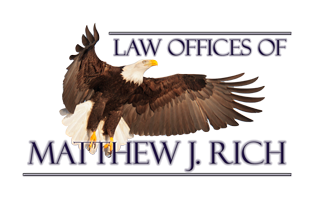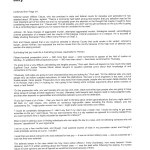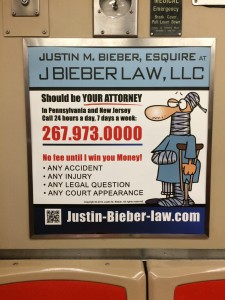Jury Selection Article
Mr. Rich was recently featured in an article in the Democrat and Chronicle regarding the importance of jury selection at criminal trials.
A short primer on police-citizen interactions
People v. DeBour, N.Y.2d 210 (1976) is the touchstone Court of Appeals case governing police-citizen interactions in New York.
One must always keep in mind that “Where a police encounter is not justified in its inception, it cannot be validated by a subsequently acquired suspicion.” People v. William II, 98 N.Y.2d 93 (2002).
DeBour set forth a four-tier framework governing police intrusion in encounters with citizens. Level one is a request for information by the officer, which is permissible when there is some objective, credible reason for that interference, although not necessarily indicative of criminal activity. Level two is the common law right of inquiry, where a police officer can request information to a greater degree than permissible under level one, and can obtain explanatory information by means short of a forcible seizure. This level of intrusion can be activated by a founded suspicion that criminal activity is afoot. Level three is a forcible stop and detention of a person where an officer has reasonable suspicion that the person has committed, is committing or is about to commit a crime. Lastly, level four allows a police officer to arrest and take into custody a person when the officer has probable cause to believe that the person has committed a crime, or an offense in the police officer’s presence.
The graduated framework set forth in DeBour for evaluating the constitutionality of police-initiated encounters with private citizens applies with equal force to traffic stops. People v. Garcia, 20 NY3d 317, 319 (2012).
Happy Holidays!!!
This story, courtesy of NBC News gave me a laugh, and it goes to show that there are a lot of great people out there who happen to also be attorneys.
Wishing you and yours all the best this holiday season.
Stranger Gives $983 So Defendant Can Avoid Felony Charge
A generous stranger gave a defendant in a Portland courtroom nearly a thousand dollars last week so the man wouldn’t be charged with a felony. Castor Conley was busted for buying and selling a stolen car that was part of a greater criminal operation, his lawyer, Lawrence Taylor, told NBC News.
“My client was minimally involved in what was otherwise a big case,” Taylor said, but the prosecutor decided not to charge Conley with a felony if he could repay the original owner of the car its $983 value. Conley was given five weeks to come up with the money, but he was unable to. Taylor was discussing his client’s predicament with someone else when a civil attorney overheard.
The civil attorney, Colin Murphy, “out of nowhere, took me aside and made the offer that he’d be willing to help out,” Taylor said. He said he would give Conley the $983, as long as the Bar Association permitted the gesture, since lawyers can’t give funds to their clients. But “a lawyer who isn’t involved in the case is no different than anyone else,” and Murphy was allowed to supply Conley with his redemption cash. “I’ve never seen anything like it — not even close,” said Taylor, who has been practicing law for 23 years.
Conley is a husband and father of a 17-month-old, with one prior misdemeanor, and felony charge could have resulted in Conley losing his job, Taylor said.
— Elisha Fieldstadt
Edit (11:21 p.m.):
On the other side of the coin…
Mysteries of the Grand Jury
In the wake of the decision of the grand jury regarding the shooting of Michael Brown in Ferguson, Missouri, I have had several clients and friends ask about how a grand jury works and what may or may not have been done properly in Ferguson. I will freely admit that I have not read the published findings of the grand jury in that case nor have I read any of the transcripts of the testimony of Officer Wilson or any of the other witnesses. However, I can try to shed some light on how the grand jury operates here in New York.
The tradition of the grand jury finds its origins in English Common Law. In American jurisprudence it arises from the Bill of Rights, specifically Fifth Amendment of the Constitution: “No person shall be held to answer for a capital, or otherwise infamous crime unless on a presentment or indictment of a Grand Jury…”
Through constitutional and statutory authority, in New York, the basic idea is that a person cannot be convicted of a felony unless their case has been reviewed by a grand jury and an indictment has been issued (unless they waive that right as part of a plea deal). At the grand jury, the standard of proof is far lower than at a trial: in order to secure an indictment, there must be reasonable cause to believe a felony has been committed. At a trial, of course, the prosecution must prove guilt beyond a reasonable doubt, a far higher standard.
The grand jury is made up of 23 people, drawn from the community in the same way that people are called to regular jury duty. The grand jury typically sits for a month-long term, however that may be extended due to special circumstances. Here in Monroe County there are typically three grand jury panels sitting at any one time. Grand Jury I sits just about every day. Grand Juries IIA and IIB sit on a more part time basis. Their chambers are in the basement of the Hall of Justice and are quite nice, actually, having just been replaced within the last 10 years.
Grand Jury used to sit on the second floor of the Hall of Justice where the Custody and Visitation parts of Family Court are now located. This is a much more public area of the building, and it led to some tense interactions when the media would attempt to gain access for high profile cases, such as the matter of former Greece Police Chief Merritt Rahn. Security basically had to push the cameras back and makeshift barriers were erected from office dividers. It was pretty humorous, actually.
On any given day, there may be less than 23 grand jurors present, but in order to function a “quorum” of no less than 16 must be there and an indictment cannot be secured with less than 12 votes. The Grand Jury may hear very few cases in a given day, or it may hear dozens. It depends on whether or not there are many new felony arrests that the DA’s Office wants to indict ahead of a scheduled Preliminary Hearing.
The Grand Jury is “empaneled” (sworn in and given initial instructions) by a Monroe County Court Judge. On a day to day basis, the DA’s Office administers the proceedings of the Grand Jury. That is to say, they control the scheduling of the panels and decide which cases to present. It is the responsibility of the prosecutor presenting a case to the Grand Jury to instruct them on the law and answer any legal questions that they may have.
So, a typical presentation to the Grand Jury will proceed like this. Let’s say the case is an assault with a deadly weapon. The prosecutor presenting the case will begin the proceeding by asking the Grand Jury foreperson (the grand juror who basically chairs the proceedings) how many grand jurors are present, and then asks the Grand Jury clerk (the grand juror who acts as the secretary) what the case number is. The prosecutor will then identify the name of the defendant, and state the charge. In our example that is Assault in the Second Degree. The prosecutor will then read the definition of Assault in the Second Degree right out of the Penal Law.
Keep in mind at this point that neither the defendant, nor his attorney, are present. There is no judge in the room. It’s only the prosecutor, the stenographer, and the grand jurors.
The prosecutor will then call witnesses and present evidence. In our Assault example, the victim may be called to testify, and a police investigator if the defendant made incriminating statements or an identification procedure was conducted such as a lineup or photographic array. The prosecutor may introduce evidence such as a certified copy of the victim’s medical records regarding the treatment of his injuries, or certified laboratory reports of testing done on the weapon or DNA analysis.
Grand jurors may ask legal questions of the prosecutor as the presentation proceeds, and may ask factual questions directly to the witnesses.
Once the presentation is complete, the prosecutor will ask the grand jurors if there are any further questions. If not, the prosecutor tells them it is time for their vote. The prosecutor and the stenographer then leave the room while the panel deliberates. Once that is done, and it usually only takes a few minutes, the foreperson invites the prosecutor and the stenographer back into the room. The prosecutor asks for the vote, which is relayed by the clerk: so many to bill, and so many to no bill. As said, if there are more than 12 votes to bill, the case is now indicted and will be referred to County or Supreme Court for proceedings leading up to trial.
Another possibility is that the grand jury may decide to “return” a case, that is to say issue what is called a “prosecutor’s information” charging the defendant with a misdemeanor. In that instance the case is sent back or “returned” to city or town court for proceedings there.
A defendant has the absolute right to testify on his own behalf at grand jury if he has been arrested on a felony charge, and the prosecutor must inform him of the time when he can do so. Any witness who testifies in grand jury has immunity from prosecution regarding the subject matter of his testimony. Obviously then, for a defendant to testify, he must waive his right to immunity. This is done so in writing and orally in front of the grand jurors. The defendant has the right to have his attorney present, but the defense attorney cannot participate in or speak at the proceedings.
Anything a defendant says in grand jury can be used against him later on at trial. Many of my clients initially express a strong desire to testify at grand jury. Most of the time, however, I advise them not to do so. Remember, the standard of proof is much lower at grand jury. Unless a client has information to offer that I am very confident will result in a no bill vote, then there is little reason to offer testimony that can be harmful to a client later on.
The proceedings of a grand jury in New York are secret, in terms of what cases are considered, the identities of witnesses, the content of testimony, and the deliberations of the grand jurors. Their decisions become public on charges when indictments are handed up, but the transcripts of the case are only seen by the prosecution and the judge when he or she reviews those transcripts later on after a motion to review the transcripts and/or dismiss the indictment is made by the defense.
The defense does not get to see the transcripts of witness testimony until right before that person testifies at a hearing or trial. These transcripts are generally referred to as Rosario material. Obviously if such a witness testifies at a hearing or trial in a manner that is inconsistent with what they said at grand jury then they can be cross examined with an eye toward impeaching their credibility.
Understand that the prosecution is in almost complete control of what evidence the grand jury does and does not see. As a matter of strategy, if a prosecutor intends to secure an indictment, he or she will likely only present as much evidence or call as many witnesses as is absolutely necessary to meet the lower standard of proof. Witnesses may only be asked about a small portion of their knowledge about a case. This deprives the defense the opportunity to find inconsistencies or mistakes in witness’ testimony that can be used later on at trial.
As for any evidence or witnesses that the defense may want the grand jury to consider, the defense attorney must advise the prosecutor of the desire to have that go before the grand jury. The prosecutor then asks the grand jurors if they want to see or hear these evidence or witnesses, and the grand jurors decide by voting on the matter. The defense has no absolute right, beyond the testimony of the defendant, to compel the grand jury to consider any evidence or witnesses that the grand jury does not wish to see or hear.
The prosecution is also in exclusive control of what charges are read to the grand jury. In our assault example, the prosecution may choose to read the misdemeanor charge of Assault in the Third Degree as an option for the grand jurors to consider, or may opt for a more “all or none” strategy in only reading the felony Assault Second charge.
If a prosecutor has a case that he or she is not confident can be a winner at trial, they may choose to present no evidence at all to the panel. which will result in a no bill. This is referred to locally as a “walk in.” On the other hand, if a prosecutor is undecided about whether an indictment is appropriate, he or she may present most or all of the evidence in a case to the grand jury, on the thought that if the totality of the evidence cannot convince the panel to indict at the lower standard of proof then there was really never any chance that the case could be proven at trial.
This latter option is what I believe happened in Ferguson, and in a more local example, in Ontario County in the case involving the young man killed at the dirt track when he was hit by Tony Stewart’s race car.
Now obviously, this lengthy diatribe only gives the broad strokes of grand jury practice. There is a lot more subtlety and strategy that goes into it. As a defense attorney, I consider it a great advantage to my clients that I have extensive experience as a prosecutor in having worked with the grand jury.
Hopefully this clears up some confusion and misconceptions about the operation of the grand jury system here in New York.
Radio Show Regarding Town Courts
Continuing my recent media tour (ha!) please also check out an appearance I made last week on Evan Dawson’s “Connections” program on WXXI Radio 1370. The other guest was David Andreatta from the D&C.
The topic of the show originated with David’s column in the paper a few weeks back on some pretty ridiculous behavior by town justices who happened not to be attorneys. As you may or may not know, town justices in New York State are not required to be attorneys, although most are here in Monroe County.
As I said on the show, I have never personally witnessed anything like the level of misconduct David touched on in his column, and I do not feel that the law should be changed to mandate that all town justices be attorneys. In fact, the guest who came on the show after me did a pretty good job outlining the extensive training and resources required of and available to town justices.
******
As a side note I was calling in from my sister in law’s car in the parking lot of Purina Farms in someplace called Gray Summit, Missouri. Actually the dog show featuring Frisbee tossing, agility/obstacle courses and long distance pool jumping was pretty cool. Somehow I can’t see my dog having the attention span to make the team.




